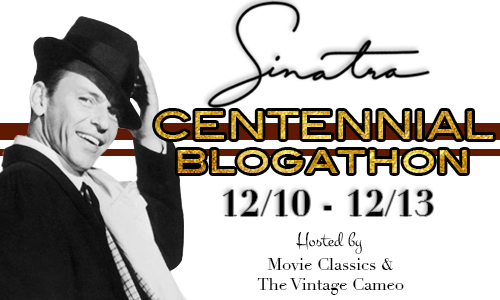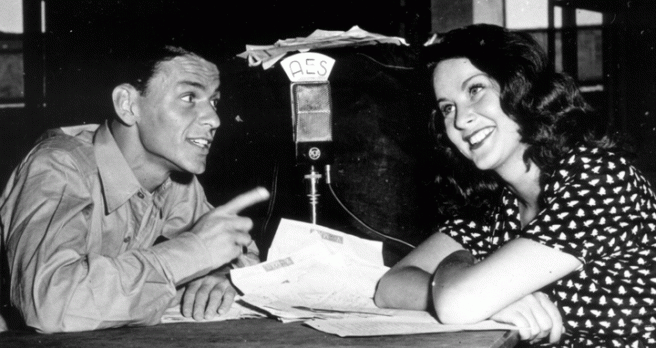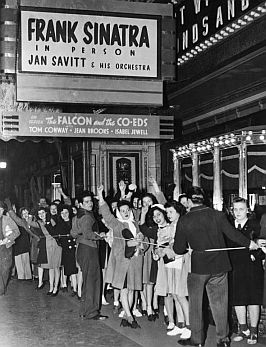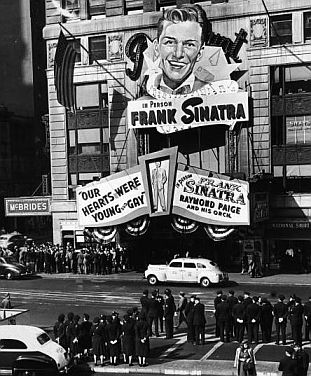Happy heavenly 97th birthday to my favoritest writer, Aleksandr Isayevich Solzhenitsyn!

Emily of The Vintage Cameo and Judy of the Movie Classics blog are hosting the Sinatra Centennial Blogathon, in celebration of the 100th anniversary of Frank’s birth. I barely even had to think to know I wanted to cover the teen idol phase of his career, and all those screaming girls. First, my character Violet was one of those hysterical fans (and cried like a baby when Frank passed on in 1998), and second, it’s very similar to my Good Bands, Fast Popularity, Teenybopper Marketing series (More of The Monkees, Seven and the Ragged Tiger, Herman’s Hermits, and The Beatles on Capitol Records).
No matter what generation, young girls will always go crazy over a fantasy crush, be it Rudy Valentino, Frank Sinatra, The Beatles, or Duran Duran. It’s a harmless way to channel normal sexual energy with nowhere to go, particularly in an era like the Forties, when fantasizing was pretty much all a so-called respectable girl could do when she wasn’t married. So long as she knows it’s just a fantasy crush and she’ll in all likelihood never even meet this guy, what’s the harm? If a teen idol has staying power past the initial rush of screaming girls, so much the better!

Frank’s tenure as a teen idol had its genesis in the Thirties, when he became the lead singer of The Hoboken Four and got most of their female fans’ attention. However, Sinatramania really began when he persuaded Tommy Dorsey to let him record some solo songs in January 1942. As a member of The Tommy Dorsey Band, he’d had huge Billboard hits with songs like “Imagination” and “Everything Happens to Me,” but those were as part of the band, not a solo artist in his own right.
Until this time, popular music was made and intended for adults, and teenagers had barely just started to come into their own as an important, separate demographic. No one had thought teenagers, let alone teenage girls, could have that much power to create musical stars. His fans also included women in their early twenties, who were frequently single by default after most of the men went off to war. By his opening at New York’s Paramount Theatre on 30 December 1942, the so-called bobby soxers screamed almost loud enough to deafen, fainted in the aisles, mobbed the back door for his autograph after the show, and impeded traffic in nearby Times Square.
People whose conception of history and popular culture only extends within their own lifetimes just can’t understand how big a deal this was to all these young women, and why they’d go so crazy. Just because you can’t understand why such and such a person or thing was considered sexy, sensational, new and exciting, etc., in a previous era, doesn’t mean these female fans had very sheltered lives or only fainted because their corsets were laced too tightly. Try to look at it in context, not judging by what you as a 21st century person finds shocking or sexy. I hate this attitude of “Let’s laugh at our ancestors for not having modern tastes and reactions.”

Frank’s show by the Paramount was so popular, his engagement was extended till February 1943, four entire weeks. Though he first played with Benny Goodman and then with an orchestra led by Johnny Long, it was always obvious whom the real draw was. At all the succeeding shows, the bobby soxers continued screaming and fainting for their new teen idol. Such a frenzied reaction hadn’t been seen since the days of Rudy Valentino a generation earlier. It wasn’t just his singing talent and the fact that his songs were popular, but his looks. Newsweek called it mass sexual delirium, while other sources wrote the bobby soxers off as juvenile delinquents and immoral. Women as old as 40 joined the Sinatra fan clubs which quickly proliferated.
Frank played to another huge crowd by the City College of New York and the Hollywood Bowl in August 1943, just two stops on a national tour that year. At every stop, the screaming crowds didn’t stop coming. He also started acting in 1944, in the films Higher and Higher and Step Lively. In October 1944, by the Paramount, he drew such a giant crowd the cops had to break up the riots which broke out when fans refused to leave after already seeing one show. Almost no one left the theatre, and sat through as many as a dozen shows over 6–8 hours.

Many of those screaming young women grew up to remain a loyal fan base who helped to keep Frank popular and relevant for another 50 years. If you truly love a singer, band, or actor, that love will still be there after the initial hype has gone, and that fandom will mature beyond a teenage crush on a pop star.
************************
Today, the 29th of Kislev, the 5th day of Chanukah, is my Hebrew birthday. There’s a tradition that on one’s Hebrew birthday, one has the power to give and receive blessings, so I’d like to bless all of you with health, happiness, success, peace, love, and luck in the coming year, and that you should all enjoy very happy holidays.

I’m tempted to say that kids back then had better taste than most kids today. I guess I said it, but it’s worth noting.
Arlee Bird
Wrote By Rote
LikeLike
I agree! I honestly can’t see the appeal of the vast majority of today’s pop music.
LikeLike
Very interesting piece – the link with the reaction to Valentino hadn’t struck me, but yes! Also, great to think that some fans stuck with Sinatra for the rest of his career. Thanks for taking part in the blogathon!
LikeLike
Great info on his early career and the adulation of his young fans. Those girls were CRAZY for “Frankie”, and it’s not hard to see why. He had talent and charisma, which always trumps an expensive marketing firm, in my opinion.
LikeLike
Frank really started something and the younger generations have never stopped flexing their consumer muscles.
LikeLike